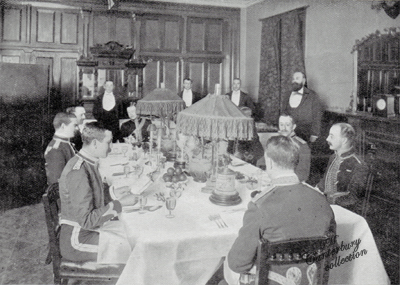
![]()
~ CAVALRY BARRACKS ~
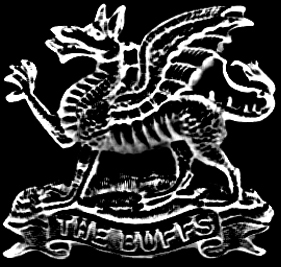
CANTERBURY
May 1794
Monday 26. The first brick laid in the foundation of the new barracks, to be erected by order of government, on the north side of the city of Canterbury, for the reception of a regiment of cavalry.
New Cavalry Barracks at Canterbury
When the measure of erecting national barracks, for accommodating the
military, in preference to quartering them upon the publicans, had been
sanctioned by parliament, various permanent buildings of this description
were begun in different parts of the kingdom, exclusive of numerous
temporary constructions for the same purpose, during the present war.
Canterbury being usually the head quarters for a regiment of horse in
times of peace, the innkeepers and publicans of that city soon felt
the great increase of the army very severely, and, therefore, were among
the first to petition for a removal of the heavy burden of quartering.
Accordingly, at the beginning of the year 1794, sixteen acres of fine
pasture land, part of the estate of Sir Edward Hales, bart. Were purchased
by the Board of Ordinance, for the purpose of building barracks sufficient
to receive a regiment of cavalry upon the ordinary establishment.
The first brick in these elegant and extensive works, was laid on May
6(*), 1794; and October 1, 1795, the New Romney light dragoons commanded
by colonel Cholmeley Dering, marched in as the first occupiers.
They are situated near Barton Mills, about half a mile N.E. from the north gate of the city, on the E. side and adjoining the high road to the Isle of Thanet nearly opposite and commanding a pleasing view of the fine seat of Hales-place, distance nearly three quarters of a mile across the Stour valley; from the W. bank of which river the annexed sketch is taken.
*I have a note from the Kentish Register for Monday, May 26th...The first brick laid in the foundation of the new barracks, to be erected by order of government, on the north side of the city of Canterbury, for the reception of a regiment of cavalry. p195
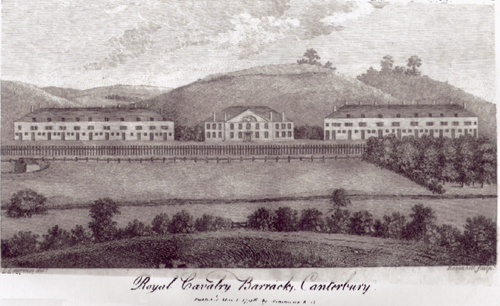
The buildings are of brick, with sashed windows; the covering, slates. In a semicircle is the pediment, are the royal arms, with supporters, and appropriate military emblems, of artificial stone by Spencer. The whole cost, including purchase of the ground, furniture, &c. is estimated at about 40,000l. A lofty palisade surrounds the whole. Three sides only of the quadrangle are built upon; in the centre are handsome apartments for the officers, suitable to their respective ranks; detached from those, on the right and left, range the stabling, and accommodations for the subalterns and privates, in a double storey over them; at each end, detached, are the officers mess-house, riding-school, forage barns, and granaries; additional stabling, the suttling house, the guard houses and other accessory offices, leaving the spacious area in the front open, for the purposes of exercise.
The situation is very pleasant and healthy,
being on a dry soil, having a gentle declivity, and constant supply
of fine water. KR

Map of the Barracks c.1843
1859, Marriage at Canterbury Cathedral - January 25, 1859. Joshua HARROD, age 40, widower of the Cavalry Barracks, Army, son of John HARROD and Eliza Ann WELLS, of Palace Street, Spinster, Milliner, daughter of Blott WELLS
April 3 1864, George Cortlandt Buller TAYLOR, Cavalry Barracks Canterbury, Lieutenant - bankrupt (H. M. 19th Hussars) Pet April 9, May 3 at 11. Waldron, Lamb's Conduit St.
1865 Richard HOLDEN, residence Cavalry Barracks, Canterbury
CAVALRY BARRACKS, CANTERBURY - 1865
To J. WILKINSON, Esq., Principal Veterinary Surgeon
January 31, 1865
"Sir, - I have the nour to bring to your notice an epidemic which has lately attacked the horses of the cavalry depot, but has been very prevalent for the last two months in this neighbourhood; and I have been informed attended with great mortality (one farmer alone having lost eleven horses by it). It is essentially a disease of the mucous membrane, attended with fever of an asthenic type, and although I have pursued the ordinary system of naming the disease according to the part of the mucous membrane apparently most implicated as 'influenza, catarrh, gastero-enteritis, and gastritis mucosa,' I believe I should this month have named all such cases, with perhaps one or two exceptiosn 'Gastritis Mucosa' for we had in them clear evidence of derangement of the stomach....
I have the honor to be, Sir
Your obedient servant,
W.C. LORD, Cavalry Staff
1866
"First Class Schoolmaster John Steward of the Cavalry Depot, Canterbury, to be superintending schoolmaster, under provisions of hte Royal Warrant of May 19th."
1874
South-Eastern District
"Deputy Surgeon-General Watt remarks that the health of the troops in the district has been satisfactory. In the early part of the year, scarlatina prevailed extensively among the children of soldiers at Canterbury, and measles amongst those at Dover. The disease in both instances seems to have been carried into barracks from the town, but it did not extend to the troops."
"The population of this city has greatly increased since the commencement of the late war, and the erection of permanent barracks for the miltiary, on the high road to Thanet, about half a mile from Northgate. The Royal Cavalry Barracks were built out of brick, in the year 1794, at the expence of about 40,000l including the purchase of sixteen acres of ground. Near these, additional barracks for 2000 infantry were erected in 1798, and have since been made a permanent station for detachments of the royal horse and foot artillery. The present number of inhabitants is supposed to be betwen 12 and 13,000 and the number of houses about 2000. 1817
CAVALRY DEPOT 1882
Commandant, Colonel J.C. Le Quesne*
Superintendent Riding Department, Major Wm. Blenkinsop**
Riding Master, Thomas Henry Jones ***
Paymaster, Major W. J. Carden**** (staff paym. a pay dept)
Instructor of Musketry, Captain Peter Marrow, 1st Dragoon Guards*
*In 1920 there was the death of Mary Marrow age 69, widow of Peter Marrow, Major Kings Dragoon Guards. Died July 16 1920 in Dunbar
Adjutant, Captain Henry Ashton Case, 12th Lancers *born c. 1851 Papplewick, Northamptonshire. Living at 7 Barton Mill Lane in Canterbury in 1881, age 30, Captain 12th Lancers., wife Mary L. (29) born Madras, India, daughter Violet (2) and Cicely (9 months) born Canterbury. Was a Student at the Royal Military College in Berkshire at age 20 in 1871
Quartermaster, Henry Woods
*14th Light Dragoons - J. C. LeQuesne, Gent., to be Cornet, by purchase, vice Redmayne, promoted - The United Service Magazine 1856
** Serjeant Major William Blenkinsop to be Cornet, 10th Light Dragoons (war office, 23rd December, 1853). 1881 "The Barracks", St. Mary Northgate, Canterbury, age 60 born c. 1821, Chester, Cheshire. Major in the Army. Wife Elizabeth (born Ireland), daughter Annie Maud 19 born East Indies, son Alfred Percy age 15, Soldier, born Ireland. - Hart's Annual Army List, Militia List, and Imperial Yeomanry List - 10th (The North Lincolnshire) Regiment of Foot, Quarter-Master Wm. Blenkinsop,6 13 Aug. 29 6 Quarter-Master Blenkinsop was present at the action before Alcoy in Spain (shows 12 years and under full pay) - Son Lt.-Col. Layton John, A.V.D. D.S.O., MRCVS of the Junior United Service Club, London, was born June 27, 1862, and is son on Col. Wm. Blenkinsop. He was educated at King's School Canterbury, and Royal Veterinary Coll, Lond. He joined the army vet. dept. Sept. 1883, Senior Vet. Officer, Array of Occupation in Egypt 1896-99 (medal with Khartoum clasp and Egyptian medal, D.S.O.) He also served in the S.A. War 1889-1902, as S.V.O. to the Cavalry Div. under Sir John French, and afterwards as S.V.O. Remount Dept, S.Africa (promoted Major, medal with six clasps, King's medal with two clasps). Col. Blenkinsop is at present P.V.O. in Ireland. "The Anglo-African who's show and biographical sketchbook 1907"
***Thomas Jones age 40 Riding Master, Cavalry Depot, born Gloster, Bristol, wife May Ann Jones (Bath Somerset), daughters Ethel and Blanche 11 & 9 born Canterbury, Kent, sons Thomas (4), Henry (2) born Ireland, son Herbert (1) born Canterbury.
****12 Capt. W. J. Carden served in the Eastern campaign at the siege of Sebastopol (Medal and Clasp) - 77th (The East Middlesex) Regt. of Foot - Hart's Annual Army List, Militia List, and Imperial Yeomanry List In 1881 William Joseph Carden (47, b. Tipperary Ireland) is living in Fulwood, Lancashire, Captain Army Pay Department with his wife Anne J. Carden (born in Canada West, British subject) son Sydney (15) and John (14) both born Hamps, and daughter Kathleen L (13) born Malta (British subject). He was at the Royal Military College in Berkshire in 1851 at age 18 (Gentleman Cadet). To be Lieutenants without purchase. Ensign William Joseph Carden, vice Forster Dated 6th June 1854. Depot Battalions "To be instructors of Musketry" Captain William Joseph Carden, 77th Foot. Dated 11th December, 1856.
1892
A fire at the cavalry barracks at Canterbury destroyed an extensive range of buldings, occupied as stables and married men's quarters. There was almost a complete absence of water, so that the progress of the flames was unchecked.

Aiming Drill, Canterbury Cavalry Barracks, 1897
ROYAL EAST KENT YEOMANRY CAVALRY (Duke of Connaught's Own Mounted Rifles) 1882
Earl of Guilford*, lieut.-col
Capt. Mervyn
C.S. Tynte, adjutant
Rev. J. H. H. Hallett, chaplain
Surg.-Major Cosmo G. Logie, surgeon
Veterinary surgeon (vacant)
WO12/12212-29 Canterbury (Cavalry Depot), general must books and pay lists 1859-78
Volunteers 1798-1813 WO 13/4387
Officers Mess, Cavalry Depot Canterbury 1897
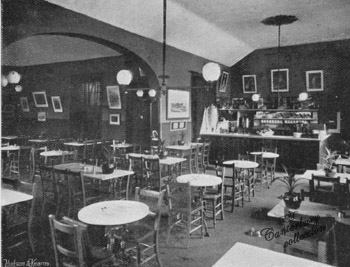
Supper Room, Cavalry Depot Canterbury 1897
CAVALRY DEPOT - 1897
National archives at Kew have records for the Cavalry Depot Canterbury W016/1281 to 1289 covering 1878 to 1888*Muster books and pay lists
1901 Plans and Sections of Buildings in the Cavalry Barracks Canterbury. WO78/3098
Cavalry Depot WO334/53
Cavalry Record Office, Canterbury WO76
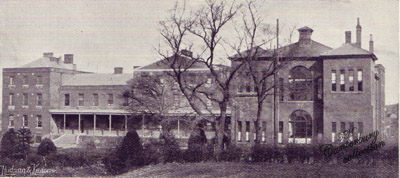
Canterbury Military Hospital 1897
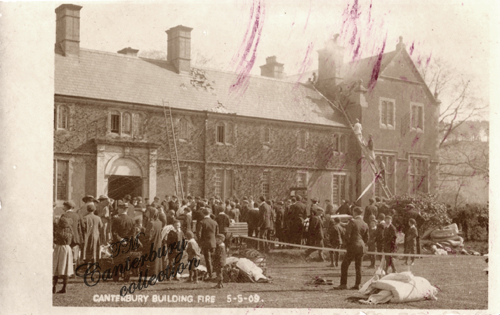
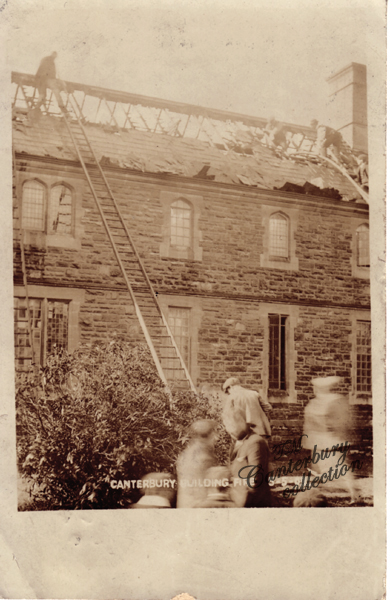
Canterbury Building fire May 5, 1909 part of the military barracks
Motto "Veteri Frondescit Honore"....."With its Ancient Honour it is Evergreen"
© T. Machado 2007
